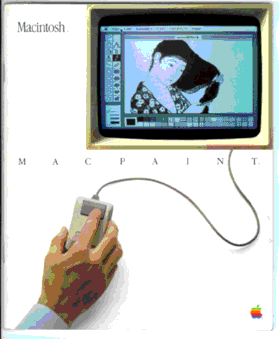
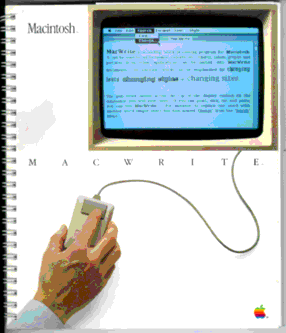
Home <https://www.channld.com>
Experienced in developing commercial application software for Macintosh computers since 1985. Here are some images of some products from that era.
| In 1984, a Macintosh computer had (and what seems to be meager in retrospect) one-eighth of a megabyte (128 kB) of RAM, 64 kB ROM, a 400 kB floppy disk (no hard disk) and 8 MHz (MC68000) CPU, yet supported these fabulous and innovative applications: |
 |
 |
Above: User manuals for MacPaint and MacWrite, included with 1984 Mac 128.
|
Image of the cover of our well-worn, all-in-one, original 1985 "Phone Book" editions of Inside Macintosh (280 pp., plus index) for software developers. |
Our May 1984 vintage, original Macintosh "128" emerging from its tote bag. (It has the signatures of the original Mac team, including Steve Jobs, embossed inside the case, not visible unless the computer is disassembled). For $2499.00 in 1984, you got a 8 MHz 68000 processor, 128 kB of RAM and a 400 kB 3.5" floppy disk. Hard disk? Except for enterprising third parties, not available until 1987, with the Mac II (hard disk with 20 MB capacity). The blue and white sticker was a visitor's pass from IBM's T. J. Watson Research Center in Yorktown Heights, NY. - 1986. |
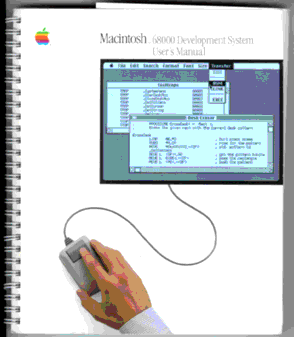 |
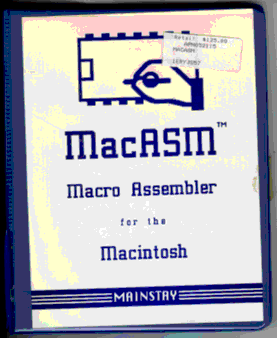 |
Above: Assembly language software development systems that we used in 1985.
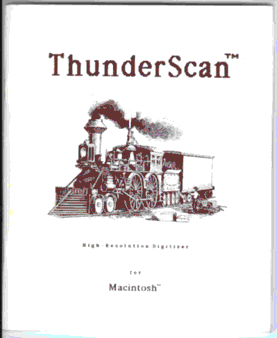 |
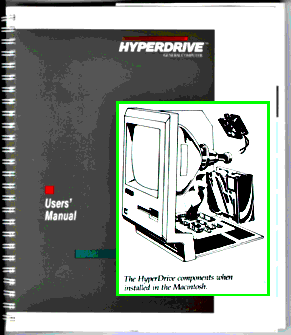 |
|
ThunderScan, a "High Resolution Digitizer for Macintosh" (original user manual, 1984). ThunderScan was the first document and image scanner for a personal computer (thank you, Andy Hertzfeld)! A cleverly designed optical cartridge replaced the ribbon cartridge in the (dot-matrix, 144 dpi) ImageWriter printer. The document was fed through the printer for scanning. |
HyperDrive (1984). HyperDrive was a $2000, 10 megabyte (later 20 MB) hard drive that was designed to be installed inside the Macintosh case. The interface cable clipped on the CPU. This provided an innovative and important performance enhancement, and preserved and enhanced the portability of the Macintosh design. The inset figure is an illustration from the HyperDrive Users' Manual. |
Above: Some additional nostalgia. Keep in mind that prices were in 1984 dollars (not adjusted for inflation; they would be much higher today...)
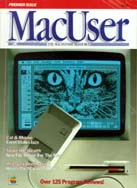 |
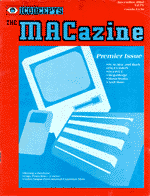 |
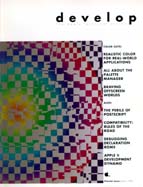 |
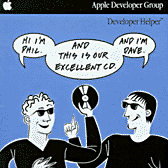 |
| Thumbnail image of the cover of our first issue of MACUSER (October, 1985). | Thumbnail image of the cover of our first issue of MACAZINE (December, 1984). | Thumbnail image of the cover of our first issue of DEVELOP (January, 1990), the extremely informative Apple programming journal (the in-depth technical articles, that complemented those in MacTech, are missed). | Thumbnail image of the cover of the first Developer CD (Vol. I, with Finder "creation date" of April 25, 1989). Click here to see thumbnails of a few other Developer CD covers... |
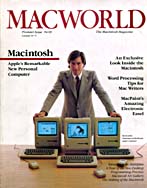 |
Thumbnail image of the cover of our first issue of MACWORLD (May / June, 1984). (That's Steve Jobs on the cover.) This is when it all began... Among other gems, this issue also contained a 4-page interview with Mr. Gates - conducted by David Bunnell, then the Chairman of MACWORLD - PC World Communications, Inc. Quoting Mr. Bill from the interview:
|
At least he didn't say "sea change" in the interview.
|
The Mac II featured a 40 MB Quantum hard drive (the first factory - provided hard drive) and a 16 MHz Motorola 68020 CPU. The MC68881 (and later MC68882) math coprocessor included with Mac II computers supported the needs of scientific and technical users. Last upgraded to Mac OS 7.5.3, our 1987** Mac II's original 40 MB hard drive still is purring along smoothly as the boot drive (with over 10 MB of room to spare)! The computer has been sent "to the farm" to serve as an adminstrative (WP) machine. It remains connected to the company Ethernet (via adapter card), driving a rock-solid (>80 lb), 1989 vintage, 19" (1024 x 768) RasterOps monitor as its main screen. It's still "alive" and earning its keep. UPDATE: The Mac II and RasterOps monitor still were chugging along faithfully as of May 2004. However, they are being decomissioned (unplugged) - in a preserved state. Sadly, energy consumption is the reason, and more economical options are available. **in "Mac" years, that's a long time: the great-great-great-great-great-great grandparent of the Intel Core Duo: e.g., 68020-> 68030-> 68040-> PPC601 / 603-> PPC604-> G3 -> G4 -> G5 -> Intel What the different processor generations introduced (starting with the 1984 Macintosh "128"):
|